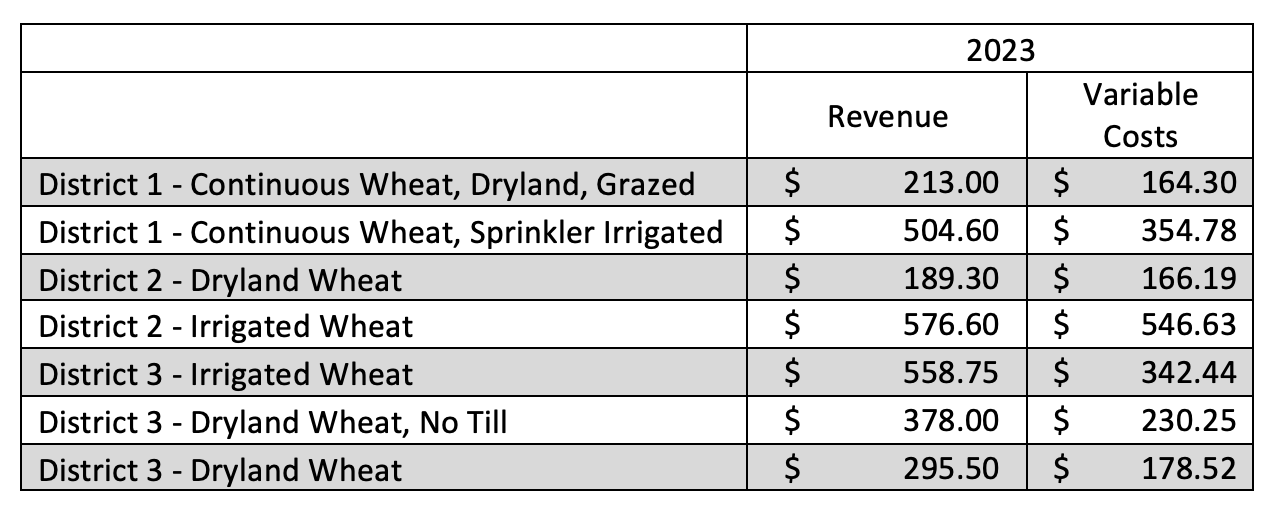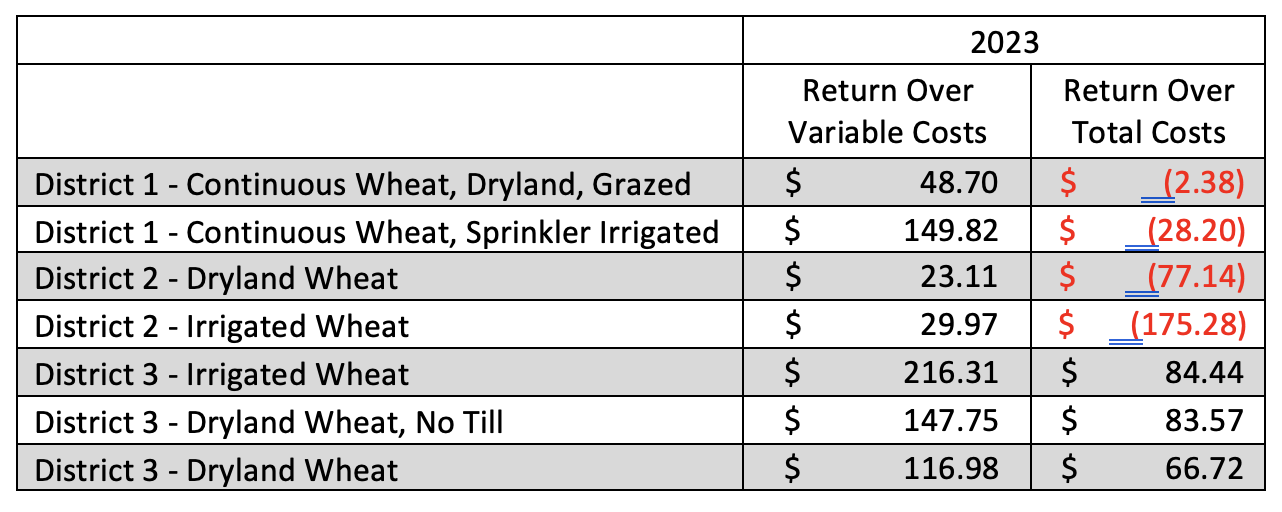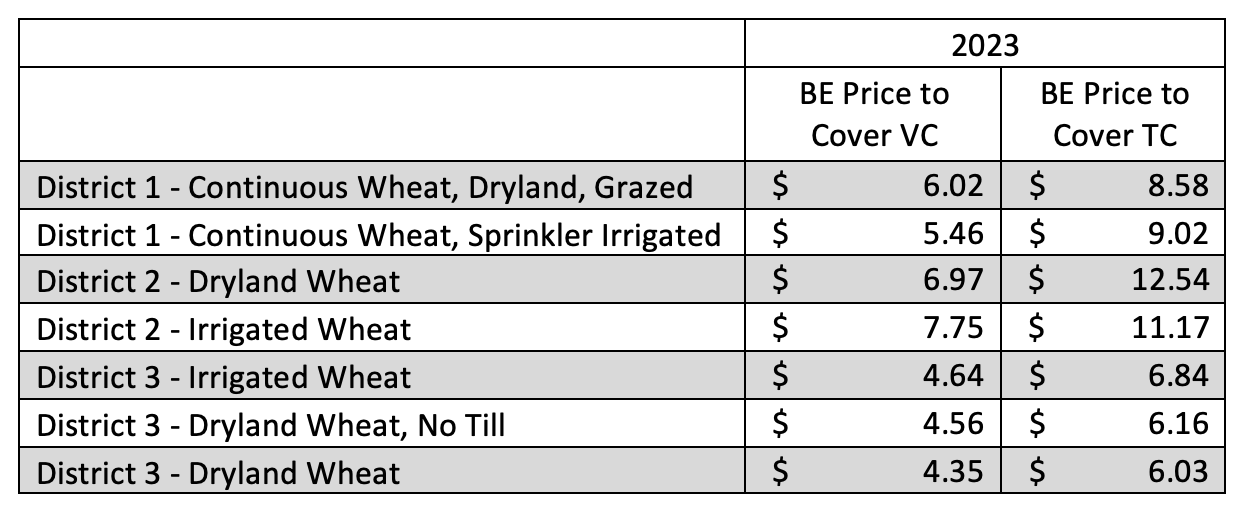 The 2023 crop and livestock budgets for District 1 are posted, and the budgets will soon be available for all districts on the AgriLife Extension Agricultural Economics website. Today, we take a look at the expected costs and returns from wheat in the High Plains.
The 2023 crop and livestock budgets for District 1 are posted, and the budgets will soon be available for all districts on the AgriLife Extension Agricultural Economics website. Today, we take a look at the expected costs and returns from wheat in the High Plains.
Board Update 1/6/2023

Tulia, Amarillo, Dalhart Average – Cattle Prices by Category 1/6/2023

Dates & Deadlines
2/8-9/2023 – Southwest Beef Symposium – Retained Ownership and Feed Costs
2/9/2023 – Parmer County Cotton Conference – Bovina
2/17/2023 – 2023 Angora Goat Testing – Initial Weigh Day and Shearing
2/21/2023 – Soil Health Clinic – Olton
2/23/2023 – Vernon Master Marketer Program
2/28/2023 – Spring Mini Ag Conference – Groom/Claude
4/25-26/2023 – Hemphill County Beef Conference, Canadian
What We’re Reading
Cattle inventory confirms large-scale contraction – Morning Ag Clips
The Cattle Price Discovery and Transparency Act – Morning Ag Clips
Hay supply near 50-year low, prices near record highs – AgriLife Today
Cotton harvest aid: A bit of science, a bit of art – Southwest Farm Press
A Look at the 2023 Wheat Budgets
Texas A&M AgriLife Extension economists around the state are in the process of completing and posting annual budgets. These budgets provide an expectation of production expenses, revenues, and profits. Table 1 summarizes the revenue and variable cost numbers on a per-acre basis in the 2022 and 2023 extension budgets for various wheat production options in Districts 1, 2, and 3 in 2023. This accounts for production
Table 1. Wheat Returns ($/acre)

In the budgets, an increase in the expected price of wheat year to year from roughly $7.60/bu. to $8.46/bu. between 2022 and 2023 is competing in many cases with an increase in the cost of production. For example, variable cost of production for sprinkler irrigated wheat in District 1 rose from $298/acre in 21/22 to $354/acre in 22/23, a 19% increase.
As a result of the expected increase in variable costs, the expected returns from wheat grain are mixed in 2023 relative to 2022. Some profits are available, if wheat emerged in the first place. Table 2 compares the expected per-acre returns above variable costs (ROVC) and returns above total costs (ROTC) for different wheat enterprises across the northern region of Texas.
Table 2. Expected Per-Acre ROVC and ROTC

From Table 2 you can see that, despite being lower, ROVC and ROTC remain positive in certain regions. The increased expenses of wheat production balanced against an moderate increase in expected price support, have driven returns into positive territory for some wheat enterprises, while keeping them close to a loss in other cases.
Breakeven Prices for 2023
One important value to be aware of in an enterprise budget is the commodity’s breakeven price. This is the price at which you can expect revenue to exactly equal costs, given the expected level of production in the budget. Table 3 lists the breakeven prices to cover both the variable costs and the total costs reported in the 2023 wheat budgets.
Table 3. Breakeven Prices to cover ROVC and ROTC

Using Drlyand Wheat in District 2 as an example, the expected yield per acre in the budget is 18 bu. plus some revenue from grazing. If this yield is achieved, then an acre of dryland wheat will break even on its variable costs at a price of $6.97/bu. and will break even on its total costs at a price of $12.54/bu. Using the expected prices in the budget, it appears that, all wheat enterprises in the northern three AgriLife districts will profit above variable costs from the production of wheat. Only District 3 values show expected profits above fixed costs.
Some Final Comments on the Budgets
There are a couple of things to keep in mind as you use this information and as you use the budgets for your district. First, the numbers in these budgets are general guidelines for wheat enterprises in their respective districts and will not represent every operation perfectly. To build a budget that better represents your operation, AgriLife offers tools to help you build your own budgets on our website. One other thing to keep in mind is that the outlook for the 2023 wheat market is not yet fully formed. To stay up to date on the latest grain marketing information, and the outlook for the wheat market, make sure to check out Dr. Welch’s website. While there, make sure to sign up for his weekly email newsletter as well.
Expectations for ARC/PLC Payments
Expected prices are still well above the effective reference price for PLC and unless severe yield challenges present this will eliminate ARC-CO payment possibilities too, so wheat prices are once again unlikely to trigger a payment under either of these programs this year. The maximum 2023 corn reference price is $5.50/bu. If you are considering enrolling in either ARC or PLC programs in 2023, the Agricultural and Food Policy Center at Texas A&M University has a decision tool you can use to help you understand the probability of receiving a payment. The deadline to enroll in these programs is March 25, 2023.